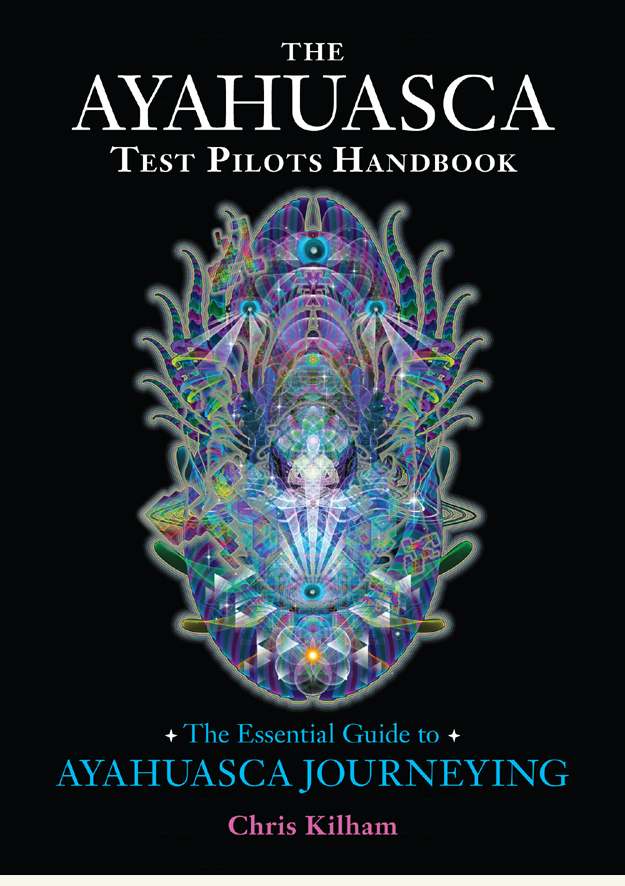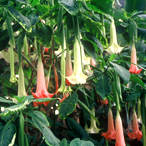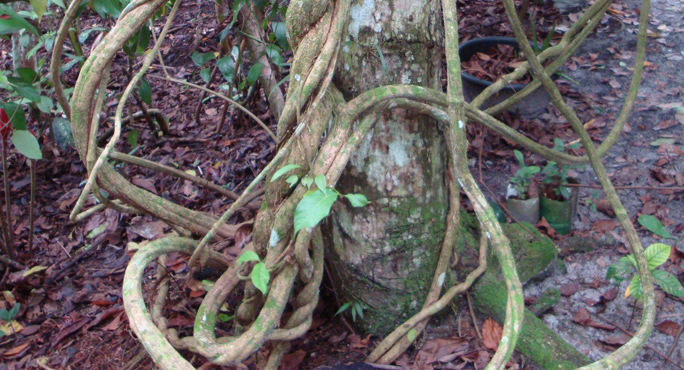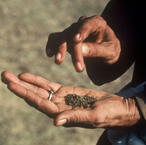Caapi Vine, Peruvian Amazon. Photo by: Chris Kilham © 2010
In the world of plants, some are used for sacred and ceremonial purposes, to explore the spirit world. The use of these plants derives from native cultures, whose members have traditionally sought access to the supranormal through the ingestion of the plants and their preparations. The use of these plants differs from contemporary religious practices in a key way. For while religious prayer, ritual and communion are engaged to propitiate god or gods, the use of sacred plants is intended to give the participant direct access to the divine experience. The difference is not slight but radical.
Additionally, the sacred plants are used for healing purposes. True healing puts into order the body, mind and spirit with the past, present and future. Such integration is possible by various means, including by the ceremonial use of the sacred plants. Throughout history these plants have been employed to heal disorders of body, mind and spirit, and today a whole new emerging body of study is currently examining the healing properties of some of these plants.
Many will balk at the notion of a spirit world, and will prefer to insist that the activity of the sacred plants is chemical, and that visions of the divine or spontaneous healings are purely acts of the individual mind. I would suggest, however, that those who think this way have never sat up all night in a peyote ceremony, or have never drunk ayahuasca with a highly trained shaman, and thus have not actually had the experience about which they speculate. For the true traveler, the sacred plants open up the world of spirit pure and simple. We hold these truths to be self evident.

AYAHUSACA TEST PILOT'S HANDBOOK
Chris Kilham's latest book, The Ayahuasca Test Pilots Handbook: The Essential Guide to Ayahuasca Journeying, provides a practical guide to ayahuasca use, aiding seekers in making right—and safe—decisions about where to go, who to drink with, and what to expect.
“Finally, a well-researched and well-written book on that most powerful of all Amazonian plants! The best book on ayahuasca since Narby's The Cosmic Serpent.” - Mark Plotkin, ethnobotanist and author, Tales Of A Shaman’s Apprentice
Banisteriopsis caapi & Psychotria viridis
True healing puts into order the body, mind and spirit with the past, present and future. What kind of agent or method or formula or treatment can help to effect such sweeping, integrated healing? I offer for your consideration ayahuasca, a psychoactive potion indigenous to the Amazon rainforest, and the only combinatory vision-inducing agent in the world. Made from the vine Banisteriopsis caapi (often called caapi) and the leaf Psychotria viridis, (known as chakruna) ayahuasca is both a portal to the spirit world, and an enigma that has baffled scientists and anthropologists for centuries. For among those with whom the ceremonial healing use of ayahuasca is a way of life, the brew is referred to as “La Medicina,” the medicine.
"On the other side of the spirit veil, I spend more than a little bit of time researching the hallucinogens. I personally believe ayahuasca [a psychedelic Amazonian brew] is also the greatest natural healing agent, period." - Chris Kilham, Psychology Today
Cannabis species
Cannabis has been used for thousands of years, and is the most widely consumed illicit substance on earth. Originating from northern Asia, cannabis enjoys many hundreds of studies, and shows numerous benefits fro health. At Medicine Hunter, we offer information on both the cultural and health uses of cannabis. The criminalization of cannabis is itself a crime, and we advocate the complete legalization of this plat and its use. Cannabis is safer than either tobacco or alcohol, both of which are legal and deadly. Enjoy our articles and segments.
“As state and local laws mutate and change in favor of greater tolerance, perhaps cannabis will find it’s proper place in the home medicine chest.” - Chris Kilham
Psilocybe species
When the hippy movement broke out in full bloom in the 1960s one agent of change in the trick bag of the movement was magic mushrooms. The other big hallucinogen of the time was LSD, originally discovered in the laboratories of Sandoz Pharmaceuticals in Basel, Switzerland, by chemist Albert Hofmann. Dr. Hofmann took up analysis of the magic mushrooms, finding in them two alkaloids, psilocybin and psilocin.
“The psychedelic genie is now officially out of the bottle, and the beneficial effects of magic mushrooms are being discussed in hospitals and clinics, and in regulatory offices.” - Chris Kilham, Fox News Health
 Brugmansia
Brugmansia
Brugmansia, known among people of South America as the “Tree of The Evil Eagle,” is a potent medicinal and psychoactive plant that has played a prominent role in South American Andean and Amazonian medicine and shamanic practice for centuries. All parts of the plant, especially the leaves and the flowers, have been employed as medicine. It has also been used in rituals and ceremonies for establishing contact with long-departed ancestors.
“Brugmansia, a beautiful plant with bell-shaped blossoms, yields both beneficial medicines still widely in use today. However, it can create a toxic and potentially fatal experience when consumed orally. Like many medicines, this plant shows great value, but it must be handled with extraordinary care.” – Chris Kilham
Lophophora williamsii
The official sacrament of the Native American Church, peyote is a cactus native to the Rio Grand River Valley, parts of the southwestern United States, and northern Mexico. Peyote cactus contains the psychoactive alkaloid mescaline. The dried “buttons,” either whole or ground, plus a tea made from them, are consumed in all-night ceremonies to experience spirit directly.
“True healing puts into order the body, mind and spirit with the past, present and future. Such integration is possible by various means, including by the ceremonial use of the sacred plants.” - Chris Kilham
Trichocereus pachanoi
Profuse throughout the Andes, San Pedro cactus is similar to peyote. San Pedro Cactus also contains the psychoactive alkaloid mescaline. Typically, shamans prepare the cactus by boiling it in water and concentrating the liquid through slow evaporation. The liquid is then drunk to induce a spiritual journey. The dried cactus can also be eaten. As with peyote, San Pedro cactus opens the doors to the spirit world.
“For the true traveler, the sacred plants open up the world of spirit pure and simple. We hold these truths to be self evident.” - Chris Kilham
Use of the sacred plants is not for everybody. Those who think they should not try them should listen to their own best advice. But for those who do feel drawn to these plants, they can open up entirely new worlds of experience, what Carlos Castaneda referred to as “a separate reality.” The sacred plants hold esteemed positions in the cultures from which they originate, and are now drawing to them explorers from all parts of the globe.



